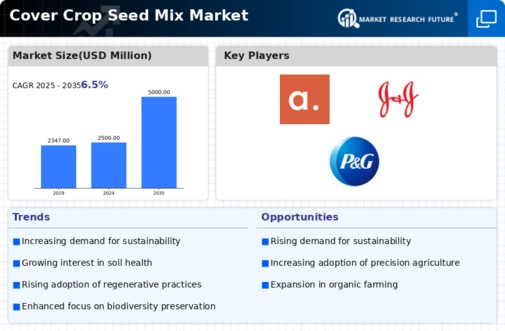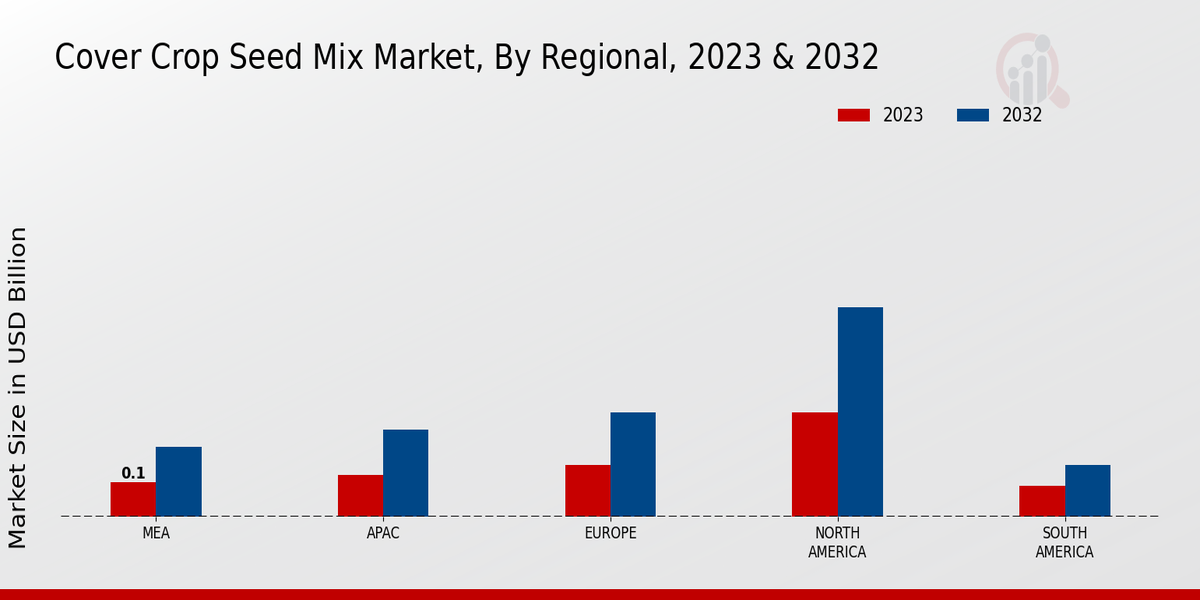Market Growth Projections
The Global Cover Crop Seed Mix Market Industry is projected to experience substantial growth over the next decade. With an estimated market value of 2500 USD Million in 2024, it is expected to reach 5000 USD Million by 2035. This growth trajectory indicates a robust demand for cover crop solutions as farmers increasingly recognize their benefits in enhancing soil health and agricultural sustainability. The anticipated compound annual growth rate (CAGR) of 6.5% from 2025 to 2035 underscores the market's potential as agricultural practices evolve to meet the challenges of modern farming.
Rising Awareness of Soil Health
The growing awareness of soil health among farmers is a significant driver of the Global Cover Crop Seed Mix Market Industry. As soil degradation becomes a pressing concern, farmers are increasingly recognizing the importance of maintaining soil fertility and structure. Cover crops are known to enhance soil organic matter, improve nutrient cycling, and suppress weeds. This awareness is further fueled by educational programs and workshops organized by agricultural extension services. Consequently, the market is expected to experience a compound annual growth rate (CAGR) of 6.5% from 2025 to 2035, as more farmers adopt cover cropping practices to ensure long-term soil health.
Climate Change Adaptation Strategies
The impact of climate change on agriculture necessitates adaptive strategies, thereby influencing the Global Cover Crop Seed Mix Market Industry. Cover crops can help mitigate the effects of climate variability by improving soil resilience and enhancing water retention. Farmers are increasingly turning to these practices to combat droughts and heavy rainfall events, which are becoming more frequent due to climate change. This shift towards climate-smart agriculture is likely to drive market growth, as farmers seek solutions that not only protect their crops but also contribute to environmental sustainability. The market's expansion reflects a broader commitment to adapting agricultural practices in response to climate challenges.
Government Incentives and Support Programs
Government policies and incentives play a crucial role in shaping the Global Cover Crop Seed Mix Market Industry. Many countries have implemented programs that provide financial assistance or subsidies to farmers who adopt cover cropping practices. These initiatives aim to promote soil conservation and enhance agricultural productivity. For instance, in the United States, programs like the Environmental Quality Incentives Program (EQIP) encourage farmers to integrate cover crops into their operations. Such support not only boosts farmer participation but also contributes to the overall growth of the market, which is projected to reach 5000 USD Million by 2035.
Growing Demand for Sustainable Agriculture
The increasing emphasis on sustainable agricultural practices drives the Global Cover Crop Seed Mix Market Industry. Farmers are increasingly adopting cover crops to enhance soil health, reduce erosion, and improve water retention. This trend is supported by various government initiatives promoting sustainable farming techniques. As of 2024, the market is valued at approximately 2500 USD Million, reflecting a growing awareness of environmental stewardship among agricultural producers. The adoption of cover crops is expected to rise as more farmers recognize their benefits, potentially leading to a more resilient agricultural system.
Technological Advancements in Seed Development
Innovations in seed technology are transforming the Global Cover Crop Seed Mix Market Industry. Advances in breeding techniques and genetic engineering have led to the development of cover crop varieties that are more resilient, disease-resistant, and adaptable to various climatic conditions. These technological improvements enhance the effectiveness of cover crops in achieving desired agricultural outcomes. As farmers gain access to these advanced seed varieties, the adoption rate is likely to increase, further propelling market growth. The integration of technology in seed development aligns with the broader trend of precision agriculture, which aims to optimize farming practices for improved yield and sustainability.





